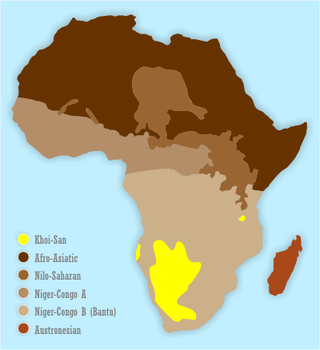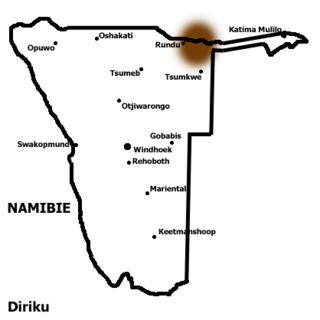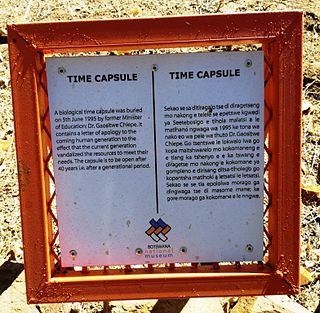Related Research Articles

The Khoisan languages are a number of African languages once classified together, originally by Joseph Greenberg. Khoisan is defined as those languages that have click consonants and do not belong to other African language families. For much of the 20th century, they were thought to be genealogically related to each other, but this is no longer accepted. They are now held to comprise three distinct language families and two language isolates.
The Kavango people, also known as the vaKavango or haKavango, are a Bantu ethnic group that resides on the Namibian side of the Namibian–Angolan border along the Kavango River. They are mainly riverine living people, but about 20% reside in the dry inland. Their livelihood is based on fishery, livestock-keeping and cropping. The Kavango Region of Namibia is named after the people.

The Caprivi Strip, also known simply as Caprivi, is a geographic salient protruding from the northeastern corner of Namibia. It is bordered by Botswana to the south and Angola and Zambia to the north. Namibia, Botswana and Zambia meet at a single point at the eastern tip of the Strip, which also comes within 150 m (490 ft) of Zimbabwe thus nearly forming a quadripoint. Botswana and Zambia share a 150-metre (490 ft) border at the crossing of Kazungula. The territory was acquired by then-German South West Africa in order to provide access to the Zambezi River and consequently a route to the east coast of the continent and German East Africa. The route was later found not to be navigable because of the location of the Victoria Falls, one of the world's largest waterfalls, about 65 kilometres east of the Caprivi Strip.

KhweKWAY is a dialect continuum of the Khoe family of Namibia, Angola, Botswana, South Africa, and parts of Zambia, with some 8,000 speakers.

Herero is a Bantu language spoken by the Herero and Mbanderu peoples in Namibia and Botswana, as well as by small communities of people in southwestern Angola. There were 250,000 speakers in these countries between 2015 and 2018.
ǃKungKUUNG (ǃXun), also known as Ju, is a dialect continuum spoken in Namibia, Botswana, and Angola by the ǃKung people, constituting two or three languages. Together with the ǂʼAmkoe language, ǃKung forms the Kxʼa language family. ǃKung constituted one of the branches of the putative Khoisan language family, and was called Northern Khoisan in that scenario, but the unity of Khoisan has never been demonstrated and is now regarded as spurious. Nonetheless, the anthropological term "Khoisan" has been retained as an umbrella term for click languages in general.

The 250 or so "Narrow Bantu languages" are conventionally divided up into geographic zones first proposed by Malcolm Guthrie (1967–1971). These were assigned letters A–S and divided into decades ; individual languages were assigned unit numbers, and dialects further subdivided. This coding system has become the standard for identifying Bantu languages; it was a practical way to distinguish many ambiguously named languages before the introduction of ISO 639-3 coding, and it continues to be widely used. Only Guthrie's Zone S is (sometimes) considered to be a genealogical group. Since Guthrie's time a Zone J has been set up as another possible genealogical group bordering the Great Lakes.
Kwangali, or RuKwangali, is a Bantu language spoken by 85,000 people along the Kavango River in Namibia, where it is a national language, and in Angola. It is one of several Bantu languages of the Kavango which have click consonants; these are the dental clicks c and gc, along with prenasalization and aspiration.

Gciriku or Dciriku, is a Bantu language spoken by 305,000 people along the Kavango River in Namibia, Botswana and Angola. 24,000 people speak Gciriku in Angola, according to Ethnologue. It was first known in the west via the Vagciriku, who had migrated from the main Vamanyo area and spoke Rugciriku, a dialect of Rumanyo. The name Gciriku remains common in the literature, but within Namibia the name Rumanyo has been revived. The Mbogedu dialect is extinct; Maho (2009) lists it as a distinct language, and notes that the names 'Manyo' and 'Rumanyo' are inappropriate for it.

The official language of Botswana is English, while Setswana is considered to be a national language. English, which was inherited from colonial rule, is the language of official business and most written communication. Most of the population speak Setswana, but over 20 smaller languages are also spoken. Some of the country's languages are in danger of becoming extinct.

Namibia, despite its scant population, is home to a wide diversity of languages, from multiple language families: Germanic, Bantu, and the various Khoisan families. When Namibia was administered by South Africa, Afrikaans, German, and English enjoyed an equal status as official languages. Upon Namibian independence in 1990, English was enshrined as the nation's sole official language in the constitution of Namibia. German and Afrikaans were stigmatised as relics of the colonial past, while the rising of Mandela's Youth League and the 1951 Defiance Campaign spread English among the masses as the language of the campaign against apartheid.

The population of Botswana is divided into the main ethnic groups of Tswana people (73%), Kalanga people (18%), and Basarwa (2%). The remaining 7% consist of other peoples, including some speaking the Kgalagadi language, and 1% of non-African people.
Mbukushu is a traditional Kavango kingdom on the territory of today's Namibia, Botswana, Zambia and Angola. Its people speak the Mbukushu language.

Bagani is a settlement on the south-western banks of the Okavango River in the Kavango East Region of Namibia, 200 kilometres (120 mi) east of Rundu and near the Popa Falls on the Okavango River. Bagani has a population of around 2.000 inhabitants and is homestead of the local Mbukushu kings.
Kavango may refer to:
The Kavango – Southwest Bantu languages are a group of Bantu languages established by Anita Pfouts (2003). The Southwest Bantu languages constitute most of Guthrie's Zone R. The languages, or clusters, along with their Guthrie identifications, are:
Luyana (Luyaana), also known as Luyi, is a Bantu language spoken in Zambia and perhaps in small numbers in neighboring countries. It appears to be an divergent lineage of Bantu. It is spoken by the Luyana people, a subgroup of the Lozi people.
Simaa is a Bantu language of Zambia. It was assigned by Guthrie to Bantu group K.30, which Pfouts (2003) established as part of the Kavango–Southwest branch of Bantu. Though not specifically addressed, Simaa may be in that family as well.
Mashi (Kamaxi), or Kwandu, is a Bantu language of Zambia and Angola. It was assigned by Guthrie to Bantu group K.30, which Pfouts (2003) established as part of the Kavango–Southwest branch of Bantu. Though not specifically addressed, Mashi may be in that family as well.
Ndombe (Dombe) is a Bantu language of Angola. It was assigned by Guthrie to Bantu group R.10, which apart from Umbundu Pfouts (2003) established as part of the Kavango–Southwest branch of Bantu. Though not specifically addressed, Ndombe may be in that branch as well.
References
- 1 2 Mbukushu at Ethnologue (25th ed., 2022)

- ↑ Jouni Filip Maho, 2009. New Updated Guthrie List Online
- ↑ Nurse, Derek; Philippson, Gérard (2003). The Bantu Languages. Routledge. p. 37. ISBN 0700711341.